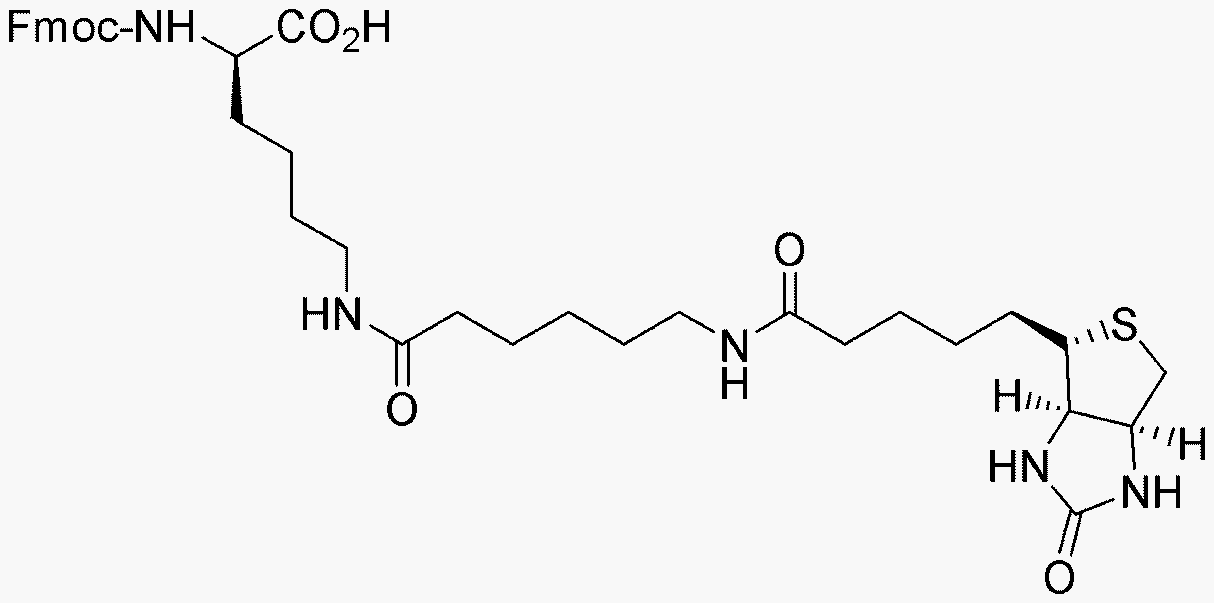Na-Fmoc-Ne-biotinyl-e-aminocaproyl-L-lysine is widely utilized in research focused on:
- Bioconjugation: This compound serves as a versatile linker for attaching biomolecules, such as proteins or peptides, to surfaces or other molecules, enhancing the development of targeted therapies.
- Drug Delivery Systems: Its biotinylation allows for specific targeting of cells expressing streptavidin, making it ideal for creating advanced drug delivery systems that improve therapeutic efficacy.
- Protein Labeling: Researchers use this compound for labeling proteins in various assays, facilitating the study of protein interactions and functions in cellular environments.
- Diagnostics: Its properties enable the development of sensitive diagnostic tools, particularly in detecting biomolecules in clinical samples, which can lead to earlier disease detection.
- Research in Molecular Biology: The compound is crucial in studies involving gene expression and regulation, providing insights into cellular mechanisms and potential therapeutic targets.
General Information
Properties
Safety and Regulations
Applications
Na-Fmoc-Ne-biotinyl-e-aminocaproyl-L-lysine is widely utilized in research focused on:
- Bioconjugation: This compound serves as a versatile linker for attaching biomolecules, such as proteins or peptides, to surfaces or other molecules, enhancing the development of targeted therapies.
- Drug Delivery Systems: Its biotinylation allows for specific targeting of cells expressing streptavidin, making it ideal for creating advanced drug delivery systems that improve therapeutic efficacy.
- Protein Labeling: Researchers use this compound for labeling proteins in various assays, facilitating the study of protein interactions and functions in cellular environments.
- Diagnostics: Its properties enable the development of sensitive diagnostic tools, particularly in detecting biomolecules in clinical samples, which can lead to earlier disease detection.
- Research in Molecular Biology: The compound is crucial in studies involving gene expression and regulation, providing insights into cellular mechanisms and potential therapeutic targets.
Documents
Safety Data Sheets (SDS)
The SDS provides comprehensive safety information on handling, storage, and disposal of the product.
Product Specification (PS)
The PS provides a comprehensive breakdown of the product’s properties, including chemical composition, physical state, purity, and storage requirements. It also details acceptable quality ranges and the product's intended applications.
Certificates of Analysis (COA)
Search for Certificates of Analysis (COA) by entering the products Lot Number. Lot and Batch Numbers can be found on a product’s label following the words ‘Lot’ or ‘Batch’.
*Catalog Number
*Lot Number
Certificates Of Origin (COO)
This COO confirms the country where the product was manufactured, and also details the materials and components used in it and whether it is derived from natural, synthetic, or other specific sources. This certificate may be required for customs, trade, and regulatory compliance.
*Catalog Number
*Lot Number
Safety Data Sheets (SDS)
The SDS provides comprehensive safety information on handling, storage, and disposal of the product.
DownloadProduct Specification (PS)
The PS provides a comprehensive breakdown of the product’s properties, including chemical composition, physical state, purity, and storage requirements. It also details acceptable quality ranges and the product's intended applications.
DownloadCertificates of Analysis (COA)
Search for Certificates of Analysis (COA) by entering the products Lot Number. Lot and Batch Numbers can be found on a product’s label following the words ‘Lot’ or ‘Batch’.
*Catalog Number
*Lot Number
Certificates Of Origin (COO)
This COO confirms the country where the product was manufactured, and also details the materials and components used in it and whether it is derived from natural, synthetic, or other specific sources. This certificate may be required for customs, trade, and regulatory compliance.


